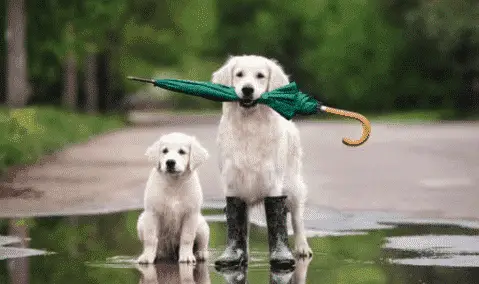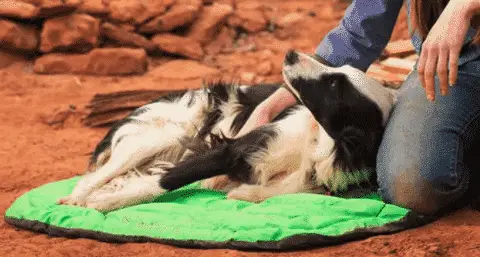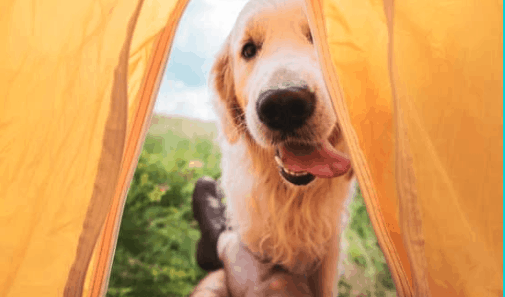When looking back and thinking about my favorite hiking companions they all shared the same common traits. They had four legs and were covered in hair! Dogs make the perfect compliment to every backpacking and hiking adventure(if they’re properly trained).
You need to ask yourself a few questions before your pup sets foot on the trail. Are they well-behaved? Do you trust them to stay by your side? Can they physically handle the rough terrain? But that’s not the most important question to ask!
Where is your dog going to sleep? Figuring out a safe and secure place for your dog to sleep should be your number 1 priority. When your passed out at 3am and your dogs wide awake, he can get into a lot of trouble fast.
Your Dog Needs To Be Ready
Before you head out on a backpacking trip you really to make sure your dog is ready both physically and mentally. You need to step back and try to look at your dog from an unbiased view point.
We all overlook the flaws in our pets that seem obvious to other people. For your dogs own safety make sure he is mature enough to go camping. He needs to be good on a leash, understand basic commands, and doesn’t run off towards distractions.
You might want to check out my post explaining when a dog is ready to go camping.
Where Should a Dog Sleep on a Backpacking Trip? Can Dogs Sleep in Tents?
Where would you want to sleep if you were a dog? Would you want to be outside exposed to the weather or warm curled up next to your owner.
Although some dogs are comfortable sleeping outside, indoor dogs should go inside the tent with their owners. They just aren’t used to sleeping outside by themselves. This means you’re going to need to dog proof your tent.
Bringing a dog inside the tent keeps them safe from bugs, predators, and limits what they can get into. You will definitely need to dog proof your gear and limit excitement in the morning before letting them out.
What if It Rains?

Throwing rain into the equation is kind of a curveball. You really don’t want a wet dog rolling over all your gear, but keeping them outside isn’t great either.
If you bring a lightweight towel to dry them off and use rain gear to separate them from your bag it should be manageable. Dogs freeze outside when temperatures dip, and moisture is going to make it worse.
You need to ask yourself a simple question. What’s more important to you? Your precious camping gear or the safety of your pup. If your gear is more important just leave the dog at home where they’ll be safe. I would also recommend going to a therapist to sort out your priorities.
Bring a Tether For Inside The Tent
Whether or not you need a tether inside your tent really depends on the dog. With the door zipped and they can’t see outside most dogs will stay inside the tent.
Problems start to arise when you leave the screen open at night. It doesn’t matter if your dog is 10lbs or 50lbs he can rip through a tent screen. For your own sanity and his safety you should seriously consider tethering the dog up to something inside your tent.
With smaller dogs you can usually just tether them up to your pack. My dog Zoey is just over 50lbs; so I had to come up with my own DIY rig.
I just wrap my old high school football belt near my waste and around the outside of my sleeping bag (doesn’t need to be tight). From there you attach a hands free running leash and you’re good to go.
The bungee cord absorbs most of the impact when she’s just walking around and would absorb the blow if she were take off. Sleeping in a tent for the first time can be stressful for nervous dogs. Expect the occasional nervous jump whenever they hear a strange noise outside.
Bring a Dog Bed

Would you want to sleep on the cold hard ground? Neither does your dog. If your dog is used to sleeping on a comfy bed at home you should bring a lightweight dog bed.
Car campers have the luxury of just bringing a regular old dog bed. If you plan on backpacking into camp you won’t have that luxury so you’ll have to find something lightweight.
You can choose between three different options. Buy a dedicated lightweight backpacking dog bed like the RUFFWEAR Highlands Bed, which is kind of expensive. Cut down a closed cell foam pad (cheap but bulky). Small dogs can even share your sleeping bag with you for a little extra warmth.
For years I carried around a cheap foam sleeping mat (like this), but it was really bulky. I eventually ended up switching over to the Ruffwear bed and it’s so much nicer. It packs down into a 12″x4″ stuff sack and weighs less than 1lb.
They also sell one that includes a built in sleeping bag (here it is) that looks awesome, but I haven’t tried it. I’ve always been a little nervous about taking Zoey out in the winter. It’s can be hard to tell if she’s getting cold so it’s better to just leave her with my parents.
Dog Proof Your Tent Floor and Sleeping Pad
Sharp dog claws can quickly tear through your tents floor/walls if you’re not careful. Either regularly trim your dogs nails at home or just pay $10 at a dog groomer. After going to work with my arms all cut up and getting lots of unwanted attention the groomer seemed like a much better idea.
Just put down a ground sheet, tarp or piece of Tyvek plastic to protect your tents floor. It might not be entirely necessary, but for the slight increase in weight it’s well worth it.
You also need to be careful with inflatable sleeping pads. I don’t care how well your dog is trained, if you have an inflatable sleeping pad he/she will lay on it. It’s just not worth risking it when you can get a Therm-a-Rest Foam Pad for less than a cheap dinner for 2.
Consider a Floorless Shelter
Backpackers always seem to either love or hate floorless shelters. There’s just something psychologically comforting about having a thin tent floor between you and the ground.
If you can get past the though of sleeping without a tent floor you should really consider getting a floorless shelter. You don’t even have to sleep on the ground. Just throw down a tent footprint and it’s basically like having a tent with a replaceable floor.
Leave Ultralight Gear At Home
Just forget about going ultralight if you’re bringing a dog. You will need tethers, dog bowls, extra food/water and heavy duty gear that can withstand sharp nails.
You just can’t get the same durability/reliability without increasing a little bit of weight. Ultralight gear just isn’t made to the same durability standards as regular camping products.




